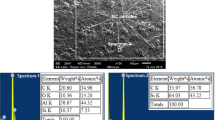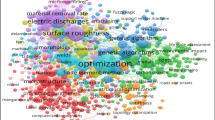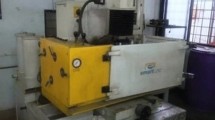Abstract
This paper presents an effort to model and optimize the process parameters involved in powder-mixed electrical discharge machining (PMEDM). Aluminum oxide (Al2O3) fine abrasive powders with particle concentration and size of 2.5–2.8 g/L and 45–50 μm, respectively, were added into the kerosene dielectric liquid of a die-sinking electrical discharge machine. The experiments were carried out in planing mode on a specially designed experimental set up developed in laboratory. The CK45 heat-treated die steel and commercial copper was used as work piece and tool electrode materials, respectively. Response surface methodology, employing a face-centered central composite design scheme, has been used to plan and analyze the experiments. Based on the preliminary and screening tests as well as the working characteristics of selected EDM machine, discharge current (I), pulse-on time (T on), and source voltage (V) were designated as the independent input variables to assess the process performance in terms of material removal rate (MRR) and surface roughness (Ra). Suitable mathematical models for the response outputs were obtained using the analysis of variance technique, in which significant terms (main effects, two factor interactions, and pure quadratic terms) were chosen according to their p values less than 0.05 (95 % of confidence interval). Having established the suitable regression equations, a search optimization procedure, based on the use of desirability functions, optimizes the process performance in each machining regime of finishing (Ra ≤ 3 μm), semifinishing (3 μm ≤ Ra ≤ 4.5 μm), and roughing (Ra ≥ 4.5 μm). The results are sets of optimum points which make the MRR as high as possible and keep the Ra and all machining parameters in their specified ranges simultaneously. Finally, the modeling and obtained optimization results were also discussed and verified experimentally. It was shown that the error between experimental and anticipated values at the optimal combination settings of input variables are all less than 11 %, confirming the feasibility and effectiveness of the adopted approach.
Similar content being viewed by others
References
Abbas NM, Solomon DG, MdF B (2007) A review on current research trends in electrical discharge machining (EDM). Int J Mach Tools Manuf 47:1214–1228
Ho KH, Newman ST (2003) State of the art electrical discharge machining (EDM). Int J Mach Tools Manuf 43:1287–1300
Takawashi T, Kobayashi K, Ito H, Sakakibara T, Saito N (1983) Study of the mirror surface finishing by planetary EDM. Proceedings of the 7th Int. Symp. on Electro Machining (ISEM-VII) UK: 137–146
Ghoreishi M, Atkinson J (2002) A comparative experimental study of machining characteristics in vibratory, rotary and vibro-rotary electro-discharge machining. J Mater Process Technol 120:374–384
Ghoreishi M, Atkinson J (2001) Vibro-rotary electrode, a new technique in EDM drilling-performance evaluation by statistical modeling and optimization. Proceedings of the 13th Int. Symp. on Electro Machining (ISEM-XIII) Spain: 633–648
Guu YH, Hocheng H (2001) Effects of work piece rotation on machinability during electrical-discharge machining. Mater Manuf Process 16(1):91–101
Lin YC, Yan BH, Chang YS (2000) Machining characteristics of titanium alloy (Ti-6Al-4 V) using a combination process of EDM with USM. J Mater Process Technol 104:171–177
Lin YC, Lee HS (2008) Optimization of machining parameters using magnetic-force-assisted EDM based on gray relational analysis. Int J Adv Manuf Technol. doi:10.1007/s00170-008-1662-7
Lin YC, Chen YF, Wang DA, Lee HS (2008) Optimization of machining parameters in magnetic force assisted EDM based on Taguchi method. J Mater Process Technol. doi:10.1016/j.jmatprotec.2008.07.052
Mohri N, Saito N, Suzuki M, Takawashi T, Kobayashi K (1988) Surface modification by EDM—an innovative in EDM with semi-conductive electrodes. Proc Winter Ann Meet ASME 34:21–30
Zaw HM, Fuh JYH, Nee AYC, Lu L (1999) Formation of a new EDM electrode material using sintering techniques. J Mater Process Technol 89–90:182–186
Meena VK, Nagahanumaiah (2006) Optimization of EDM machining parameters using DMLS electrode. Rapid Prototyp J 12(4):222–228
Kansal HK, Singh S, Kumar P (2007) Technology and research developments in powder mixed electric discharge machining (PMEDM). J Mater Process Technol 184:32–41
Kumar A, Maheshwari S, Sharma C, Beri N (2010) Research developments in additives mixed electrical discharge machining (AEDM): a state of art review. Mater Manuf Process 25:1166–1180
Singh S, Bhardwaj A (2011) Review to EDM by using water and powder-mixed dielectric fluid. J Miner Mater Charact Eng 10(2):199–230
Erden A, Bilgin S (1980) Role of impurities in electric discharge machining. Proceedings of the 21st Int. Conf. on Machine Tool Design and Research Macmillan London: 345–350
Jeswani ML (1981) Effect of the addition of graphite powder to kerosene used as the dielectric fluid in electrical discharge machining. Wear 70(2):133–139
Ming QY, He LY (1995) Powder—suspension dielectric fluid for EDM. J Mater Process Technol 52:44–54
Wong YS, Lim LC, Rahuman I, Tee WM (1998) Near-mirror-finish phenomenon in EDM using powder-mixed dielectric. J Mater Process Technol 79:30–40
Chow HM, Yan BH, Huang FY, Hung JC (2000) Study of added powder in kerosene for the micro-slit machining of titanium alloy using electro-discharge machining. J Mater Process Technol 101:95–103
Tzeng YF, Lee CY (2001) Effects of powder characteristics on electro discharge machining efficiency. Int J Adv Manuf Technol 17:586–592
Tzeng YF, Chen FC (2005) Investigation into some surface characteristics of electrical discharge machined SKD-11 using powder-suspension dielectric oil. J Mater Process Technol 170:385–391
Zhao WS, Meng QG, Wang ZL (2002) The application of research on powder mixed EDM in rough machining. J Mater Process Technol 129:30–33
Kozak J, Rozenek M, Dabrowski L (2003) Study of electrical discharge machining using powder-suspended working media. Proc IMechE B J Eng Manuf 217:1597–1602
Pecas P, Henriques E (2003) Influence of silicon powder-mixed dielectric on conventional electrical discharge machining. Int J Mach Tools Manuf 43:1465–1471
Pecas P, Henriques E (2008) Electrical discharge machining using simple and powder-mixed dielectric: the effect of the electrode area in the surface roughness and topography. J Mater Process Technol 200:250–258
Pecas P, Henriques E (2008) Effect of the powder concentration and dielectric flow in the surface morphology in electrical discharge machining with powder-mixed dielectric (PMD-EDM). Int J Adv Manuf Technol 37:1120–1132
Klocke F, Lung D, Antonoglou G, Thomaidis D (2004) The effects of powder suspended dielectrics on the thermal influenced zone by electro discharge machining with small discharge energies. J Mater Process Technol 149:191–197
Cogun C, Ozerkan B, Karacay T (2006) An experimental investigation on the effect of powder mixed dielectric on machining performance in electric discharge machining. Proc IMechE B J Eng Manuf 220:1035–1050
Yeo SH, Tan PC, Kurnia W (2007) Effects of powder additives suspended in dielectric on crater characteristics for micro electrical discharge machining. J Micromech Microeng 17:N91–N98
Chow HM, Yang LD, Lin CT, Chen YF (2008) The use of SiC powder in water as dielectric for micro-slit EDM machining. J Mater Process Technol 195:160–170
Jahan MP, Rahman M, Wong YS (2011) Study on the nano-powder-mixed sinking and milling micro-EDM of WC-Co. Int J Adv Manuf Technol 53:167–180
Kung KY, Horng JT, Chiang KT (2009) Material removal rate and electrode wear ratio study on the powder mixed electrical discharge machining of cobalt-bonded tungsten carbide. Int J Adv Manuf Technol 40:95–104
Tzeng YF, Chen FC (2003) A simple approach for robust design of high-speed electrical-discharge machining technology. Int J Mach Tools Manuf 43:217–227
Kansal HK, Singh S, Kumar P (2005) Application of Taguchi method for powder mixed electrical discharge machining. Int J Manufac Technol and Manag 7(2–4):329–341
Kansal HK, Singh S, Kumar P (2007) Effect of silicon powder mixed EDM on machining rate of AISI D2 die steel. SME J of Manufac Proc 9(1):13–22
Wu KL, Yan BH, Huang FY, Chen SC (2005) Improvement of surface finish on SKD steel using electro-discharge machining with aluminum and surfcant added dielectric. Int J Mach Tools Manuf 45:1195–1201
Prihandana GS, Mahardika M, Hamdi M, Wong YS, Mitsui K (2009) Effect of micro-powder suspension and ultrasonic vibration of dielectric fluid in micro-EDM processes-Taguchi approach. Int J Mach Tools Manuf 49:1035–1041
Kumar A, Maheshwari S, Sharma C, Beri N (2010) A study of multiobjective parametric optimization of silicon abrasive mixed electrical discharge machining of tool steel. Mater Manuf Process 25:1041–1047
Kumar S, Singh R (2010) Investigating surface properties of OHNS die steel after electrical discharge machining with manganese powder mixed in the dielectric. Int J Adv Manuf Technol 50:625–633
Montgomery DC (2009) Design and analysis of experiments, 7th edn. Wiley, New York. ISBN 978-0-470-39882-1
Myers RH, Montgomery DC (2002) Response surface methodology, 2nd edn. Wiley, New York. ISBN 0-471-41255-4
Box GEP, Hunter JS, Hunter WG (2005) Statistics for experimenters, 2nd edn. Wiley, New York. ISBN 13978-0471-71813-0
Box GEP, Draper NR (2007) Response surface, mixtures, and ridge analysis, 2nd edn. Wiley-Interscience, Hoboken. ISBN 978-0-470-05357-7
Box GEP (1985) Discussion of 'off-line quality control, parameter design, and the Taguchi method' by R. N Kackar J Qual Technol 17:189–190
Assarzadeh S, Ghoreishi M, Shariyyat M (2010) Response surface methodology approach to process modeling and optimization of powder mixed electrical discharge machining (PMEDM). Proceedings of the 16th International Symposium on Electromachining (ISEM-XVI) April 19–23 Shanghai China
Assarzadeh S, Ghoreishi M (2007) Modeling and optimizing powder mixed electrical discharge machining (PMEDM) process using neural networks. Proceedings of the 2nd Tehran International Congress on Manufacturing Engineering (TICME 2007) Iran University of Science and Technology December 10–13 Tehran Iran
Assarzadeh S, Ghoreishi M (2008) A neural network approach for powder mixed electrical discharge machining (PMEDM): modeling and optimization. Proceedings of the 9th Cairo University International Conference on Mechanical Design and Production (MDP-9) January 8–10 Cairo Egypt
Ghoreishi M, Assadi M (2004) Effects of powder additives in dielectric on the EDM process performance. Proceedings of the 6th Iranian Manufacturing Engineering Conference Tehran Iran
Derringer G, Suich R (1980) Simultaneous optimization of several response variables. J Qual Technol 12(4):214–219
Castillo ED, Montgomery DC, Mc Carville DR (1996) Modified desirability functions for multiple response optimization. J Qual Technol 28(3):337–345
Mc Geough JA (1988) Advanced methods of machining. Chapman and Hall, New York. ISBN 0-412-31970-5
Jain VK (2004) Advanced machining processes. Allied Publishers, New Delhi. ISBN 81-7764-294-4
Assarzadeh S, Ghoreishi M (2008) Neural-network-based modelling and optimization of the electro-discharge machining process. Int J Adv Manuf Technol 39:488–500
Author information
Authors and Affiliations
Corresponding author
Rights and permissions
About this article
Cite this article
Assarzadeh, S., Ghoreishi, M. A dual response surface-desirability approach to process modeling and optimization of Al2O3 powder-mixed electrical discharge machining (PMEDM) parameters. Int J Adv Manuf Technol 64, 1459–1477 (2013). https://doi.org/10.1007/s00170-012-4115-2
Received:
Accepted:
Published:
Issue Date:
DOI: https://doi.org/10.1007/s00170-012-4115-2




